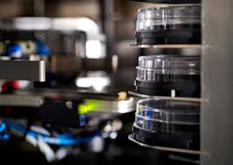blog
May 18, 2023 | Source: Rapid Micro Biosystems, Inc.
Which RMM Fits You Best?
POSTED BY Rapid Micro Biosystems | 7 minute read
May 18, 2023 | Source: Rapid Micro Biosystems, Inc.
POSTED BY Rapid Micro Biosystems | 7 minute read
Not all rapid microbial methods are alike, so consider these factors before selecting.
Today there are a variety of rapid microbial methods (RMM) platforms designed to accelerate microbial quality control. Each has its own features and benefits. But if you run a QC Micro lab and need to identify the technology that will best suit your operation, here are five factors to keep in mind as you go forward.
#1: Process Needs. Consider your supply chain requirements and testing volumes. Do you need test results in weeks, days, or just a few hours? How many samples do you expect to process each year? The answers to these questions can help you arrive at a realistic process “budget” that your ideal RMM platform should meet.
It’s worth noting that many platforms are designed for a specific type of test, such as a sterility or bioburden test, or air sampling. Depending on the tests performed, a lab might have to leverage multiple methods. In contrast, the appeal of a technology such as the Growth Direct® System is that it mimics traditional testing – supporting the same environmental monitoring, bioburden, and sterility testing that you may already be performing, including similar preparation steps.
#2: Validation Requirements. Implementing an RMM platform requires documented validation proving that the new method is equivalent to current traditional testing. System selection can be especially critical here, particularly for multinational pharma companies that deploy varied microbial testing methods, operating procedures, and reporting practices across different regions. A novel RMM that lacks a well-established validation methodology could require your QC and IT personnel to spend years on documentation, standardized assessment processes, and compliance benchmarking in hopes of creating a template that can be adopted efficiently at other sites worldwide.
If your competitive priorities don’t allow such a massive effort, an approved and proven technology such as the Growth Direct® System can offer a more straightforward validation path. Our automated compendial approach only requires the assurance of accuracy, precision, and equivalence as compared to the reference standard; it has been successfully reviewed with the FDA and EMA, and is in use by multiple companies in the United States and Europe. Equally important, Rapid Micro Biosystems’ highly experienced validation team can provide a complete suite of validation documents, services, and project management to ensure timely qualification – often in less than six months.
#3: Destructive versus Non-Destructive. An important question is whether your method will destroy cells as part of its detection process. Destructive RMMs generally provide a faster result than growth-based methods. However, a positive or out-of-specification (OOS) result can add extra steps and unfamiliar procedures in order to re-grow the microbe for identification, since the original sample has been destroyed.
In contrast, a non-destructive, automated RMM such as the Growth Direct® System allows users to recover the product for quicker identification – not to mention expedited investigation and intervention. This blend of new and traditional methods can support faster results and accelerated follow-up while still using processes similar to the compendial method.

The Growth Direct® System is the only rapid system that automates microbial QC tests and preserves samples for identification. No reagents are required, so users can proceed directly to identification without re-culturing.
#4: Detection Type. Efforts to release pharmaceutical products faster and more cost-effectively have intensified in recent years, with some RMMs opting to streamline incubation strategies or use media that can leave critical coverage gaps. This can result in considerable self-inflicted risk, with some RMM platforms, for example, failing to detect (or significantly under-report) hazardous species of mold and yeast. In contrast, the RMBNucleus™ Mold Alarm component of the Growth Direct® System emphasizes a detection methodology that features not one but two incubation temperature ranges for rigorous accuracy, specificity, and robustness.
#5: Training. Training is always necessary when implementing a new RMM, but time requirements may differ drastically. Destructive RMM technologies, for example, usually involve new reagents, new sample preparation techniques, and alternative forms of results delivery that differ from the compendial method. An automated, non-destructive method, such as the Growth Direct® System, on the other hand, automates the time-tested manual method and uses no reagents. Users will have fewer steps to perform, and the preparation steps will mirror the traditional method.
Make Your Automated QC Micro Lab a Reality
As you consider the path your QC Micro lab will take in the future, a non-destructive, growth based RMM such as the Growth Direct® System can offer the best of both worlds: not only faster results and rapid response, but efficient processes similar to the compendial method you already have in place. To get ready for the next step, download this tech sheet or contact Rapid Micro Biosystems today.